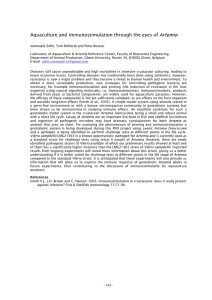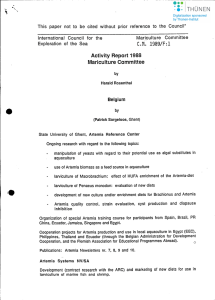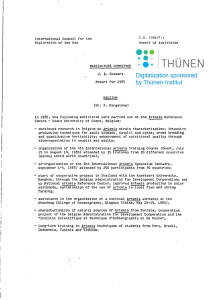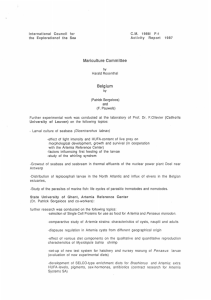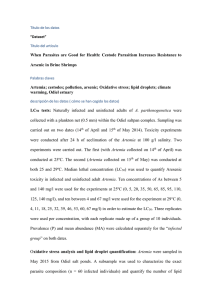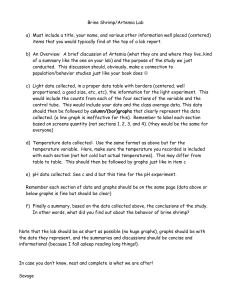parasitolres07.doc
advertisement
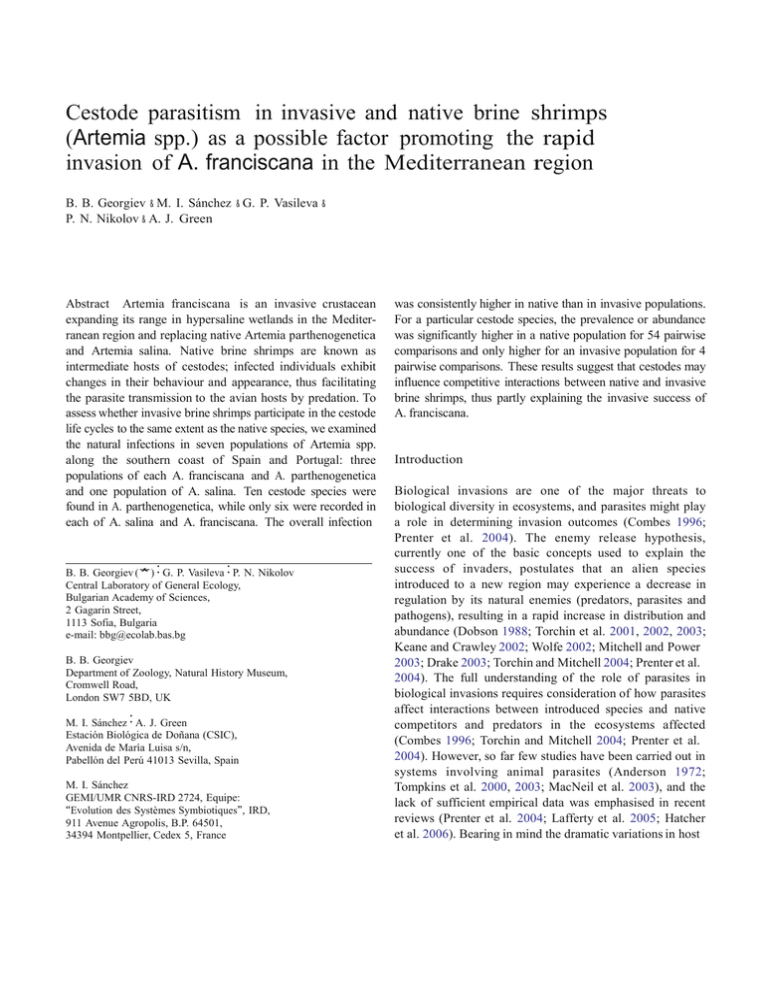
Cestode parasitism in invasive and native brine shrimps (Artemia spp.) as a possible factor promoting the rapid invasion of A. franciscana in the Mediterranean region B. B. Georgiev & M. I. Sánchez & G. P. Vasileva & P. N. Nikolov & A. J. Green Abstract Artemia franciscana is an invasive crustacean expanding its range in hypersaline wetlands in the Mediterranean region and replacing native Artemia parthenogenetica and Artemia salina. Native brine shrimps are known as intermediate hosts of cestodes; infected individuals exhibit changes in their behaviour and appearance, thus facilitating the parasite transmission to the avian hosts by predation. To assess whether invasive brine shrimps participate in the cestode life cycles to the same extent as the native species, we examined the natural infections in seven populations of Artemia spp. along the southern coast of Spain and Portugal: three populations of each A. franciscana and A. parthenogenetica and one population of A. salina. Ten cestode species were found in A. parthenogenetica, while only six were recorded in each of A. salina and A. franciscana. The overall infection B. B. Georgiev (*) : G. P. Vasileva : P. N. Nikolov Central Laboratory of General Ecology, Bulgarian Academy of Sciences, 2 Gagarin Street, 1113 Sofia, Bulgaria e-mail: bbg@ecolab.bas.bg B. B. Georgiev Department of Zoology, Natural History Museum, Cromwell Road, London SW7 5BD, UK M. I. Sánchez : A. J. Green Estación Biológica de Doñana (CSIC), Avenida de María Luisa s/n, Pabellón del Perú 41013 Sevilla, Spain M. I. Sánchez GEMI/UMR CNRS-IRD 2724, Equipe: “Evolution des Systèmes Symbiotiques”, IRD, 911 Avenue Agropolis, B.P. 64501, 34394 Montpellier, Cedex 5, France was consistently higher in native than in invasive populations. For a particular cestode species, the prevalence or abundance was significantly higher in a native population for 54 pairwise comparisons and only higher for an invasive population for 4 pairwise comparisons. These results suggest that cestodes may influence competitive interactions between native and invasive brine shrimps, thus partly explaining the invasive success of A. franciscana. Introduction Biological invasions are one of the major threats to biological diversity in ecosystems, and parasites might play a role in determining invasion outcomes (Combes 1996; Prenter et al. 2004). The enemy release hypothesis, currently one of the basic concepts used to explain the success of invaders, postulates that an alien species introduced to a new region may experience a decrease in regulation by its natural enemies (predators, parasites and pathogens), resulting in a rapid increase in distribution and abundance (Dobson 1988; Torchin et al. 2001, 2002, 2003; Keane and Crawley 2002; Wolfe 2002; Mitchell and Power 2003; Drake 2003; Torchin and Mitchell 2004; Prenter et al. 2004). The full understanding of the role of parasites in biological invasions requires consideration of how parasites affect interactions between introduced species and native competitors and predators in the ecosystems affected (Combes 1996; Torchin and Mitchell 2004; Prenter et al. 2004). However, so far few studies have been carried out in systems involving animal parasites (Anderson 1972; Tompkins et al. 2000, 2003; MacNeil et al. 2003), and the lack of sufficient empirical data was emphasised in recent reviews (Prenter et al. 2004; Lafferty et al. 2005; Hatcher et al. 2006). Bearing in mind the dramatic variations in host specificity, pathogenic effect and complexity of the life cycles and transmission strategies among the animal macroparasites, we concur with Lafferty et al. (2005) that most of our knowledge of the role of parasites in facilitating biological invasions is anecdotal and non-systematic. Furthermore, “invasion success” is a vague concept and could refer to a variety of phenomena such as chance of establishment, rate of spread, maximum population density, range size and individual growth rate (Drake 2003), each of them with varying weight at different stages of the invasion process and requiring specific research approach. Therefore, there is a vital need to increase the number of case studies on the role of parasites in biological invasions. With this study, we start the comparative examination of invasive and native brine shrimps of the genus Artemia, whose competitive interactions might be mediated by cestode parasitism. The American brine shrimp Artemia franciscana is an invasive species rapidly expanding its range in hypersaline ecosystems in the Mediterranean region since the 1980s and replacing the native Artemia parthenogenetica and Artemia salina (Amat et al. 2005). Along the coast of the Iberian Peninsula, A. franciscana is currently the only detectable species of brine shrimps in salinas in Portugal and in those in the vicinities of the city of Cádiz, Spain. The populations of A. franciscana originated as intentional or non-intentional inoculations through aquacultural (hatchery effluents) or petmarket activities; once this species is detected amongst populations of native Artemia, the latter disappear within 3 years (Amat et al. 2005; Amat et al. unpublished data). The spread of A. franciscana is enhanced by the ability of brine shrimp eggs to survive after passing through the digestive tracts of migratory birds (Green et al. 2005). Currently, suitable habitats for Artemia along the southern coast of the Iberian Peninsula show a patchy distribution of A. franciscana, A. parthenogenetica and A. salina, with no sites containing both native and introduced populations (Amat et al. 2005; personal observations). Since 2003, the replacement of native populations by A. franciscana has been detected for two new locations in Spain: the salterns at the delta of the river Ebro, Province of Tarragona and the hypersaline lagoon at Fuente de Piedra, Province of Málaga (Amat et al., unpublished data). Since A. franciscana has been introduced to areas outside its native range as cysts (resistant encysted embryos), it has not been accompanied by any native helminth parasites (e.g. cestodes). The species of Artemia are known to serve as intermediate hosts in the life cycles of 14 species of cyclophyllidean cestodes (reviewed by Georgiev et al. 2005). At the Odiel Saltpans (Province of Huelva, SW Spain), larvae of eight cestode species were described from A. parthenogenetica; as adults, three of them are parasitic in flamingos, three in waders, one in gulls and one in grebes (Georgiev et al. 2005). The life cycles of all these parasites are rather uniform: the brine shrimp is infected by swallowing a cestode egg, and a larval cestode (cysticercoid) develops and reaches infectivity after a few weeks in its hemocoel; by avian predation, the larval cestode is transmitted to the definitive host, where it matures and starts oviproduction. Cestodes are known to greatly reduce the fecundity of infected A. parthenogenetica (Amat et al. 1991). Furthermore, studies of native Artemia in Spain and France show that the cestode parasitism is associated with modifications in appearance and behaviour of brine shrimps. These include changes of the colour to intense red (Thiéry et al. 1990; Robert and Gabrion 1991; Amat et al. 1991); the increased proportion of red-coloured specimens in the population may be an indirect consequence of cestode infection, mediated by the parasite-induced positive phototaxis (Sánchez et al. 2006a). The infected specimens show increased time of surfacing behaviour, and the normal photophobic behaviour of adults is replaced by selection of luminated microhabitats, active movement to light stimuli and increased time of swimming near water surface (Sánchez et al. 2007). This increases exposure to avian predators, which are also observed to select red-coloured brine shrimps (Sánchez et al., in preparation). Thus, if the introduced A. franciscana is able to escape infection by cestodes, this could have major knock-on effects up the food chain (e.g. by reducing bird food intake). This accessible and relatively well-studied system of phylogenetically related crustaceans (Baxevanis et al. 2006) and their cestode parasites (Georgiev et al. 2005) is suitable for testing various aspects of parasite–host, host–host and parasite–parasite interactions under conditions of ongoing biological invasion. The purpose of the present study is to assess whether invasive brine shrimps participate in the life cycles of avian cestodes to the same extent as the native species in the same area. Materials and methods Within a period of 1 month (9 August–4 September 2005), we collected samples of seven populations of Artemia spp. and examined them for cestode infections. We selected this period because previous studies in the Odiel Saltpans showed that both Artemia abundance and levels of cestode infections reached maxima in the summer and early autumn (Sánchez et al. 2006b; Sánchez et al., in preparation). The present study included three populations of the native parthenogenetic A. parthenogenetica and three populations of the invasive bisexual A. franciscana inhabiting salt pond complexes along the Atlantic coast of southern Portugal and Spain (Table 1; Fig. 1). We also studied the nearest available population of the native bisexual A. salina Table 1 Sites studied and samples of Artemia spp. examined for the presence of cestode infection in August–September 2005 Saltpan complex Coordinates Date Host species Sample size (specimens) Castro Marim Salinas, Algarve Region, Portugal 37°12′N 07°26′W 9 August A. franciscana Salinas del Odiel, Huelva Province, Spain Salinas de Nuestra Señora del Rocío, Sanlúcar de Barrameda, Cádiz Province, Spain Salinas Portuguesas, Sanlúcar de Barrameda, Cádiz Province, Spain Salinas de Las Ánimas, Puerto Real, Cádiz Province, Spain Salinas de Santa Bárbara, Puerto Real, Cádiz Province, Spain Salinas de Cerrillos, Roquetas del Mar, Almería Province, Spain 37°17′N 06°55W 36°50′N 06°20′W 9 August 12 August A. parthenogenetica A. parthenogenetica 240 (140 females, 100 males) 200 (females) 200 (females) 36°53′N 06°20′W 14 August A. parthenogenetica 200 (females) 36°30′N 06°10′W 14 August A. franciscana 36°28′N 06°08′W 14 August A. franciscana 36°42′N 02°40′W 4 September A. salina 70 (30 females, 40 males)a 200 (113 females, 87 males) 200 (91 females, 109 males) a Sample size was lower at this locality because the low density of Artemia made it impractical to obtain more. occurring near Almería on the southeastern Mediterranean coast of Spain. The length of time that the A. franciscana populations have been established in the area is unknown but is likely to be less than 20 years (Amat et al. 2005). The study area shares a similar Mediterranean climate and a similar waterbird community dominated by flamingos (Phoenicopterus ruber), waders (Tringa totanus, Calidris alpina, Calidris ferruginea, Calidris minuta, Limosa limosa, Recurvirostra avosetta, Himantopus himantopus, Charadrius alexandrinus, Charadrius hiaticula), gulls (Larus cachinans, Larus genei and Larus ridibundus) and grebes (Podiceps nigricollis). All the saltpan complexes studied are protected as internationally important wetlands (‘Ramsar sites’) owing to their significance for conservation of waterbirds (Martí and del Moral 2002; Ramsar Sites Information Service 2006). The samples were collected from individual salt ponds with a 0.1-mm mesh net, and the specimens were transported alive in 5-l containers to the laboratory. The samples Fig. 1 Distribution of study sites in the Iberian Peninsula. Sites: 1 Castro Marim Salinas; 2 Salinas del Odiel; 3 Salinas de Nuestra Señora del Rocío; 4 Salinas Portuguesas; 5Salinas de Las Ánimas; 6 Salinas de Santa Bárbara; 7 Salinas de Cerrillos of A. parthenogenetica and A. franciscana were placed in shallow tanks, 50 (length) × 10 (height) × 30 (width) cm, and examined for parasites during the next 3 days. Only adults (i.e. specimens with developed gonads) were selected for examination. Each individual was studied under a microscope for the presence of cestodes. If the identification of the cysticercoids recorded was not possible at this stage, whole brine shrimps or isolated cysticercoids were prepared as permanent mounts in Berlese’s medium to facilitate observations of the rostellar hooks. The sample of A. salina was heated to 80°C to kill the cysticercoids; the specimens were then preserved in 70% ethanol and examined 3 months later in temporary glycerol mounts. The descriptions of the larval cestodes of eight species from the same area (Georgiev et al. 2005) were used as a basis for the identification of the present material; another species, Fimbriarioides tadornae, recorded for the first time in the region, was identified after comparison with its description from brine shrimps from Kazakhstan (Maksimova 1976). To compare the infection levels, we used the prevalence, mean abundance and mean intensity (Bush et al. 1997), which were calculated for the overall cestode infection and for each cestode species. We assessed the significance of the differences between populations in prevalence with Z tests (Snedecor and Cochran 1989) and in abundance and intensity with Mann–Whitney U tests using Statistica 5.5 (StatSoft 1999). P values were always Bonferroni-corrected to avoid type I errors (Miller 1991). Results Cestode infections were recorded in all the sites studied (Table 2). We found cysticercoids of ten cestode species. Eight of them were cestodes previously recorded in A. parthenogenetica in Odiel Saltpans (Georgiev et al. 2005). These were Flamingolepis liguloides, Flamingolepis flamingo and Gynandrotaenia stammeri (adults parasitic in flamingos); Wardium stellorae (adults in gulls); Confluaria podicipina (adults in grebes); Anomotaenia tringae and Anomotaenia microphallos (adults in wader of the genera Tringa and Calidris); and Eurycestus avoceti (adults in avocets). In addition, a single specimen of Fimbriarioides tadornae (adults parasitic in shelducks Tadorna tadorna) and two specimens of an unidentified hymenolepidid species were found. In A. parthenogenetica, our study revealed all the ten cestode species recorded in the area. In the single population of A. salina studied, we found six cestode species: F. liguloides, F. flamingo, W. stellorae, C. podicipina, E. avoceti and G. stammeri. The invasive A. franciscana harboured six cestode species: F. liguloides, F. flamingo, E. avoceti, A. tringae, A. microphallos and G. stammeri (Table 2). Between one and eight cestode species were recorded in each of the sites studied (Table 2). In the populations of A. parthenogenetica, the number of the cestode species varied between 5 and 8. In A. franciscana populations, there were one to six cestode species, and only one of the three populations held more than two species. The prevalence of the total cestode infection was much higher in the native hosts: 47.0–89.0% in A. parthenogenetica and 83.0% in A. salina (Table 2) compared to 2.0–24.3% in A. franciscana (Tables 2 and 3). Six cestodes species showed statistically significant differences in the prevalence values between a population of native and a population of invasive brine shrimps. These were 28 cases: 12 out of a possible 12 cases for F. liguloides, 5 for A. tringae, 3 for F. flamingo, W. stellorae and E. avoceti, and 2 for C. podicipina. In 26 of these cases, the prevalence was higher in a population of a native Artemia species (Table 3). In two cases only, the prevalence of a cestode species was higher in a population of the invasive brine shrimp; both these cases were related to A. tringae in A. franciscana compared to populations of A. parthenogenetica (Table 3). The mean abundance of the total cestode infection varied between 1.40 and 2.48 in native populations and between 0.03 and 0.27 in invasive populations (Table 2), with significant differences in all the 12 cases where abundance was compared between a native and an invasive population (Table 4). Six cestode species had significant differences in the mean abundance (Table 4). There were 30 cases of significant differences in the mean abundance of a particular cestode species between populations of native and invasive brine shrimps; in 28 of these cases, the mean abundance was higher in a native population (Table 4). Again, the exceptions were for A. tringae in the comparisons between A. franciscana and A. parthenogenetica populations (Table 4). The total cestode intensity varied between 1.09 and 1.40 in invasive and between 1.97 and 3.62 in native populations (Table 2). In all the seven cases of significant differences, it was higher in a native population (Table 4). No significant differences were found when comparing the intensity of a particular cestode species between native and invasive populations (Table 4). In each bisexual population (three populations of A. franciscana and one of A. salina), we found no significant differences in cestode prevalence, abundance or intensity between males and females. Discussion Our results demonstrate that the invasive A. franciscana can participate in the life cycles of at least six out of ten cestode species occurring in aquatic birds in the Iberian Peninsula and using native brine shrimps (A. parthenogenetica and A. salina) as intermediate hosts. These include three species that parasitise flamingos, two species occurring in waders of the genera Tringa and Calidris, and one species occurring in avocets (Georgiev et al. 2005). It is currently unclear whether A. franciscana is able to participate in the life cycles of the remaining four species because some of them have very low prevalence and may have remained undetected by the present study. For example, our previous study revealed that the gull parasite W. stellorae had a prevalence of 0.2% in brine shrimps in the Odiel Saltpans (Georgiev et al. 2005); similarly, the same study, though based on 3,300 individuals from Odiel Saltpans, did not register the shelduck parasite F. tadornae, which was found by chance at this site in the present samples. We believe that the prevalence in Artemia of some cestodes parasitising migratory birds is strongly dependent on the seasonal appearance of the final hosts at the sites Total Fl Ff Ws Cp Salinas Castro Marim, Portugal—Artemia franciscana P% 9.0 1.0 1.0 0.0 0.0 MI 1.09 ± 0.09 1.00 ± 0.00 1.67 ± 0.67 0.00 0.00 MA 0.10 ± 0.02 0.01 ± 0.01 0.02 ± 0.01 0.00 0.00 Salinas Odiel, Huelva—Artemia parthenogenetica P% 47.0 45.0 2.0 0.0 2.0 MI 3.62 ± 0.38 3.59 ± 0.38 1.00 ± 0.00 0.00 1.25 ± 0.25 MA 1.70 ± 0.22 1.61 ± 0.21 0.02 ± 0.01 0.00 0.02 ± 0.01 Salinas Nuestra Señora del Rocío, Sanlúcar de Barrameda—Artemia parthenogenetica P% 69.0 67.0 2.0 2.0 0.0 MI 2.04 ± 0.10 1.87 ± 0.09 1.00 ± 0.00 1.00 ± 0.00 0.00 MA 1.40 ± 0.10 1.25 ± 0.10 0.02 ± 0.01 0.02 ± 0.01 0.00 Salinas Portuguesas, Sanlúcar de Barrameda—Artemia parthenogenetica P% 89.0 54.0 8.0 26.0 0.0 MI 1.97 ± 0.08 1.26 ± 0.06 1.06 ± 0.06 1.15 ± 0.06 0.00 MA 1.80 ± 0.08 0.68 ± 0.05 0.09 ± 0.02 0.30 ± 0.04 0.00 Salinas Las Ánimas, Puerto Real—Artemia franciscana P% 24.3 0.0 0.0 0.0 0.0 MI 1.12 ± 0.08 0.00 0.00 0.00 0.00 MA 0.27 ± 0.10 0.00 0.00 0.00 0.00 Salinas Santa Bárbara, Puerto Real—Artemia franciscana P% 2.0 0.0 0.0 0.0 0.0 MI 1.40 ± 0.40 0.00 0.00 0.00 0.00 MA 0.03 ± 0.02 0.00 0.00 0.00 0.00 Salinas de Cerrillos, Almería—Artemia salina P% 83.0 77.0 29.0 0.5 6.0 MI 2.99 ± 0.14 2.37 ± 0.11 1.62 ± 0.12 1.00 1.15 ± 0.10 MA 2.48 ± 0.14 1.84 ± 0.11 0.47 ± 0.06 0.005 ± 0.005 0.07 ± 0.02 Ft Gs Ea At Am Cyst 0.0 0.00 0.00 1.0 1.00 ± 0.00 0.01 ± 0.01 4.0 1.00 ± 0.00 0.05 ± 0.01 4.0 1.00 0.004 ± 0.004 1.0 1.00 ± 0.00 0.01 ± 0.01 0.0 0.00 0.00 0.5 1.00 0.005 ± 0.005 0.0 0.00 0.00 3.0 1.00 ± 0.00 0.03 ± 0.01 0.0 0.00 0.00 0.0 0.00 0.00 0.0 0.00 0.00 0.0 0.00 0.00 0.5 1.00 0.005 ± 0.005 7.0 1.14 ± 0.1 0.08 ± 0.02 1.0 1.67 ± 0.67 0.02 ± 0.02 0.0 0.00 0.00 0.0 0.00 0.00 0.0 0.00 0.00 0.5 1.00 0.005 ± 0.005 30.0 1.15 ± 0.05 0.35 ± 0.04 27.0 1.11 ± 0.04 0.30 ± 0.04 1.0 1.00 ± 0.00 0.01 ± 0.01 1.0 1.00 ± 0.00 0.01 ± 0.01 0.0 0.00 0.00 0.0 0.00 0.00 4.3 1.00 ± 0.00 0.04 ± 0.02 21.0 1.07 ± 0.07 0.23 ± 0.05 0.0 0.00 0.00 0.0 0.00 0.00 0.0 0.00 0.00 0.0 0.00 0.00 2.0 1.40 ± 0.40 0.03 ± 0.02 0.0 0.00 0.00 0.0 0.00 0.00 0.0 0.00 0.00 0.0 0.00 0.00 ± 0.00 0.5 1.00 0.005 ± 0.005 8.0 1.00 ± 0.00 0.08 ± 0.02 0.0 0.00 0.00 0.0 0.00 0.00 0.0 0.00 0.00 Parasitol Res (2007) 101:1647–1655 Table 2 Prevalence (P%), mean intensity (MI, ±SE) and mean abundance (MA, ±SE) of cestodes in Artemia spp. in hypersaline wetlands at the southern coast of the Iberian Peninsula, August– September 2005 Fl Flamingolepis liguloides; Ff Flamingolepis flamingo; Ws Wardium stellorae; Cp Confluaria podicipina; Ft Fimbriarioides tadornae; Gs Gynandrotaenia stammeri; Ea Eurycestus avoceti; At Anomotaenia tringae; Am Anomotaenia microphallos; Cyst unidentified hymenolepidid cestode species 1651 Table 3 Significant differences for pairwise tests in cestode prevalence between introduced and native populations of Artemia spp. (Z test, P < 0.05 after Bonferroni correction); numbers presented represent scores for the Z tests Salinas (code) 1-2 1-3 1-4 1-5 1-6 1-7 2-3 2-4 2-5 2-6 2-7 3-4 3-5 3-6 3-7 4-5 4-6 4-7 5-6 5-7 6-7 Artemia species Af-Ap Af-Ap Af-Ap Af-Af Af-Af Af-As Ap-Ap Ap-Ap Ap-Af Ap-Af Ap-As Ap-Ap Ap-Af Ap-Af Ap-As Ap-Af Ap-Af Ap-As Af-Af Af-As Af-As Cestodes Cp Total 8.86 12.89 16.75 Fl 11.07 14.73 12.57 Ff 15.49 4.36 9.02 3.18 10.20 7.443 4.93 6.37 13.77 16.50 4.33 8.25 6.73 10.66 6.57 5.48 8.90 16.17 Ea Ws 8.34 6.68 7.19 8.37 7.84 6.43 7.05 7.05 7.24 5.47 5.89 6.87 4.28 7.41 5.43 4.63 7.67 7.46 3.73 7.32 9.51 14.09 7.32 10.37 17.36 At 3.38 7.80 12.05 4.85 7.32 3.38 11.14 15.80 4.91 8.09 3.38 7.84 7.84 6.43 6.43 Parasite species with no significant differences are not shown. Significant differences with prevalence in a native population higher than that in an invasive population are shown in bordered cells; those with a higher prevalence in an invasive population higher than that in a native population are shown in shaded cells. For the code of salinas and the abbreviations of the cestode names, see Table 2. For sample sizes, see Table 1 Af Artemia franciscana; Ap A. parthenogenetica; As A. salina studied. This may be the case of C. podicipina, a parasite of black-necked grebe P. nigricollis, which uses the wetlands in the area mostly as migratory and wintering sites (Martí and del Moral 2002; BirdLife International 2005). In the Odiel Saltpans, the prevalence of its larvae across the annual cycle was 6.5% (Georgiev et al. 2005), but the prevalence of this species was 22.5% in a subsample collected in September (Sánchez et al. 2006a). Therefore, we do not exclude the possibility that the remaining four cestode species, which occur in native brine shrimps in the area, will also be found in A. franciscana in further studies on larger samples. Similarly to our results, several other studies demonstrated the involvement of invasive animals as intermediate hosts in the life cycles of parasites circulating in the ecosystems invaded. Three species of gobies, which are recent invaders from the Black Sea region to Central Europe (Danube basin, Slovakia), participate as hosts of larvae (intermediate and paratenic) in the circulation of local helminth parasites of predatory fishes and fish-eating birds as adults, with prevalence often reaching 50–100% (Ondračková et al. 2005). Similar results were also obtained for the Ponto-Caspian gobies invading the Hungarian Danube (Molnár 2006). Krakau et al. (2006) demonstrated that two invasive bivalves in the North Sea participate in the life cycles of one and four trematode species, respectively, which normally use native bivalves as intermediate hosts in their life cycles. Our results show that the prevalence and abundance of the cestode infection in native populations are considerably higher than in invasive brine shrimps. Although our study was carried out during only 1 month, we are confident that our results reflect a general pattern as earlier observations have shown that infection rates in native Artemia are consistently high (Gabrion et al. 1982; Robert and Gabrion 1991; Georgiev et al. 2005). In a preliminary study of adult A. franciscana, we found that only 1.6% (n = 501) of those we sampled in Castro Marim in July 2002 and 0% (n = 250) of those sampled in Cádiz Bay in July 2003 showed cestode infections. Similar observations were made when comparing native and invasive bivalves in the North Sea (Krakau et al. 2006), although there are major differences between Table 4 Significant differences for pairwise tests between introduced and native populations of Artemia spp. in the abundance and intensity of cestodes (Mann–Whitney U test, P < 0.05 after Bonferroni correction); numbers presented represent scores for the U tests Salinas Artemia (code) species 1-2 Af-Ap 1-3 Af-Ap 1-4 Af-Ap 1-5 Af-Af 1-6 Af-Af 1-7 Af-As 2-3 Ap-Ap 2-4 Ap-Ap 2-5 Ap-Af 2-6 Ap-Af 2-7 Ap-As 3-4 Ap-Ap 3-5 Ap-Af 3-6 Ap-Af 3-7 Ap-As 4-5 Ap-Af 4-6 Ap-Af 4-7 Ap-As 5-6 Af-Af 5-7 Af-As 6-7 Af-As Total 14311.5 8871.0 3596.0 7117.5 Fl 13414.5 8119.5 11308.5 22267.5 4970.0 5539.5 17339.0 13066.5 4961.0 10993.0 12342.5 15735.0 5801.5 6585.5 13662.0 1613.5 2436.0 5479.5 1898.0 3661.0 Ff Mean abundance Cp At Ea Ws 17497.0 6634.5 17736.0 17640.0 350.5 516.0 22440.0 3850.0 11000.0 14096.5 15130.5 2310.0 6600.0 15639.0 3220.0 9200.0 10813.0 18300.0 15705.0 18700.0 1575.0 4500.0 4970.0 14200.0 18700.0 Mean intensity Total Fl 425.5 749.0 845.0 14500.0 5500.0 14572.0 14700.0 14821.5 5611.5 15304.0 15088.0 5153.0 14414.0 15532.0 5145.0 14700.0 14797.0 2393.5 30.5 14548.0 14548.0 18700.0 34600.0 14500.0 5500.0 5500.0 4866.5 7916.0 700.0 9988.5 3883.0 419.0 Parasite species with no significant differences are not shown. Significant differences with an abundance or intensity higher in a native population than in an introduced population are shown in bordered cells; those with a higher abundance in an introduced population are shown in shaded cells. For the names of Artemia spp., see Table 3; for the code of salinas and the abbreviations of the cestode names, see Table 2. For sample sizes, see Table 1. our findings and those in this previous study. Krakau et al. (2006) suggested that the introduced bivalves might divert parasite burdens, thus providing a relief for native species by reducing their own parasite loads. Furthermore, they suggested that introduced bivalves might negatively affect parasite populations by diverting infectious stages into “dead-end hosts”, i.e. into introduced bivalves that are not consumed by avian final hosts. In contrast, there is no prospect of A. franciscana providing a benefit to native Artemia populations by diverting their cestode parasites because native brine shrimps are eradicated from their habitats in the Mediterranean region once the invasive species becomes established (Amat et al. 2005). For example, we did not find more than one brine shrimp species in any of our samples during the present study. Furthermore, A. franciscana is not a “dead-end” host for cestodes because the same community of birds feed on the native and invasive shrimps [for data on consumption of A. franciscana by birds in the Cádiz area, see Masero and Pérez-Hurtado (2001)]. However, it is possible that the probability of transmission is lower for cestodes in A. franciscana, owing to an inability to modify host behaviour (see below). As a whole, both our observations and those of Krakau et al. (2006) suggest lower levels of infection in invasive species when acting as intermediate hosts and are consistent with the enemy release hypothesis (Dobson 1988; Torchin et al. 2001, 2002, 2003; Keane and Crawley 2002; Wolfe 2002; Mitchell and Power 2003; Drake 2003; Torchin and Mitchell 2004). However, the acquisition of a smaller number of parasite larvae by an invasive species than by the closely related native species is a phenomenon differing from those on which the enemy release hypothesis was based, and needs a new explanation. Although A. franciscana is parasitised by cestodes in its native North America (Young 1952), there are no detailed studies allowing us to compare the prevalence, abundance or intensity of infections between the native Nearctic populations of this species and the introduced populations we have studied in the Iberian Peninsula. We have found that cestodes parasitising native Artemia in the Mediterranean region can switch hosts to introduced brine shrimps. Despite this host-switching capacity, the prevalence and intensity of infections remain lower in the introduced Artemia for reasons that are currently unclear. It is possible that cestode infection of A. franciscana is partly inhibited by the immune response of the exotic host and that prevalence will increase over time as the cestodes become adapted to their new hosts. Although these cestodes appear to cause an increase in the time spent at the top of the water column in their native hosts (Sánchez et al. 2007) and are associated with the change of the host colour to intense red (Sánchez et al. 2006a), there is as yet no evidence of such effects in A. franciscana. This change in host–parasite relationship is likely to have knock-on effects up the food chain, as waterbirds feed preferentially on the red brine shrimps that concentrate at the water surface (Thiéry et al. 1990; Sánchez et al., in preparation). Therefore, the replacement of the native Artemia spp. by A. franciscana may reduce the foraging intake of birds. Similarly, any reduction in the ability of cestodes to modify behaviour and appearance of their intermediate hosts (i.e. introduced Artemia) may decrease the probability of cysticercoids reaching their final host. We expect that waterbirds using saltpans invaded by A. franciscana will have a tendency to return to the same sites in different years as suggested by repeated observations of marked individuals of grebes and flamingos in the same sites (Estación Biológica de Doñana, unpublished data). If this is the case, reduced parasite loads of these birds caused by their lower rate of ingestion of infected Artemia would in turn lead to decreased rates of releasing cestode eggs in invaded salt ponds and, consequently, reduced levels of infection in the Artemia populations. Thus, a diminished ability to manipulate intermediate hosts may reinforce the reduction in prevalence and intensity of infections in introduced Artemia populations. Differences in life history between Artemia spp. provide other potential explanations for the reduced cestode prevalence and abundance in A. franciscana. The latter species reaches sexual maturity faster than A. salina or parthenogenetic strains (Browne et al. 1984) and, under optimal laboratory conditions, can begin reproduction within 7 days of hatching (Wurtsbaugh and Gliwicz 2001). It is currently unclear at what stage of the Artemia life cycle the cestode infestation occurs, but if it is during the prereproductive growth phase, the lower prevalence and intensity in A. franciscana could be explained by its faster development and a shorter period of exposition to infective cestode eggs. Alternatively, the higher total lifespan of parthenogenetic strains (Browne et al. 1984) could also explain the high values of cestode prevalence and intensity in them. However, this could not explain the difference observed between A. salina and A. franciscana as these two species have similar lifespans (Browne et al. 1984). In these bisexual Artemia species, females live longer than males under laboratory conditions (Browne 1980; Browne et al. 1984). However, we found no significant differences in prevalence or abundance between males and females of the same bisexual population, further suggesting that total lifespan is not a good predictor of levels of infection by cestodes. Our results suggest that cestode parasites may play a role in the competitive interaction between native and invasive brine shrimps, especially as cestodes cause a reduction in the fecundity of native Artemia (Amat et al. 1991) and may also promote their predation by birds via behavioural modification (Sánchez et al. 2006a, 2007). Cestodes may thus enhance the speed with which A. franciscana can replace native Artemia populations in the wild. However, laboratory competition experiments suggest that, in the absence of cestode parasites, A. franciscana can outcompete native species and can cause the extinction of A. salina and parthenogenetic strains within three generations owing to extreme niche overlap and the greater fecundity and growth rate of A. franciscana (see Browne and Halanych 1989). Thus, we do not attribute the rapid expansion of A. franciscana in the Mediterranean region exclusively to the effects of cestodes but rather suggest that cestodes may contribute to the speed of expansion. In conclusion, the lower cestode infection levels of A. franciscana compared to native A. parthenogenetica and A. salina may partly explain the highly invasive character of A. franciscana in the Mediterranean region. Further work is required to establish whether or not all cestode species occurring in native brine shrimps can successfully switch to A. franciscana and to clarify whether they are able to reach their final avian hosts in sufficient numbers to establish viable populations if the parasite pool occurring in native Artemia hosts is eliminated. In other words, it is important to establish if cestodes can modify appearance and behaviour of A. franciscana in the same way as they do with native Artemia. If they are unable to do so, it is important to establish whether they can ensure sustainable levels of transmission to final hosts and how foraging intake and parasite burden are affected in bird populations. Acknowledgements We are grateful to Francisco Hortas for his help in the field studies in the vicinities of Cádiz. Professor F. Amat (Instituto de Acuicultura de Torre de la Sal, CSIC, Castellón, Spain) kindly commented on an earlier version of the manuscript. This study was carried out in the framework of a cooperative program between the Bulgarian Academy of Sciences and the Consejo Superior de Investigaciones Cientificas (Project 2004BG0013). References Amat F, Gozalbo A, Navarro JC, Hontoria F, Varó I (1991) Some aspects of Artemia biology affected by cestode parasitism. Hydrobiologia 212:39–44 Amat F, Hontoria F, Ruiz O, Green AJ, Sánchez MI, Figuerola J, Hortas F (2005) The American brine shrimp Artemia franciscana as an exotic invasive species in the Western Mediterranean. Biol Invasions 7:37–47 Anderson RC (1972) The ecological relationships of meningeal worm and native cervids in North America. J Wildl Dis 8:304–310 Baxevanis AD, Kappas I, Abatzopoulos TJ (2006) Molecular phylogenetics and asexuality in the brine shrimp Artemia. Mol Phylogenet Evol 40:724–738 BirdLife International (2005) BirdLife’s online World Bird Database: the site for bird conservation. Version 2.0. BirdLife International, Cambridge, UK. http://www.birdlife.org Browne RA (1980) Competition experiments between parthenogenetic and sexual strains of the brine shrimp, Artemia salina. Ecology 61:471–474 Browne RA, Halanych KM (1989) Competition between sexual and parthenogenetic Artemia: a re-evaluation (Branchiopoda, Anostraca). Crustaceana 57:57–71 Browne RA, Sallee SE, Grosch DS, Segreti WO, Purser SM (1984) Partitioning genetic and environmental components of reproduction and lifespan of Artemia. Ecology 65:949–960 Bush AO, Lafferty KD, Lotz JM, Shostak AW (1997) Parasitology meets ecology on its own terms: Margolis et al. revisited. J Parasitol 83:575–583 Combes C (1996) Parasites, biodiversity and ecosystem stability. Biodivers Conserv 5:953–962 Dobson AP (1988) Restoring island ecosystems: the potential of parasites to control introduced mammals. Conserv Biol 2:31–39 Drake JM (2003) The paradox of the parasites: implications for biological invasion. Proc R Soc Lond Ser B (Suppl) 270:S133–S135 Gabrion C, MacDonald-Crivelli G, Boy V (1982) Dynamique des populations larvaires du cestode Flamingolepis liguloides dans une population d’Artemia en Camargue. Acta Oecol 3:273–293 Georgiev BB, Sánchez MI, Green AJ, Nikolov PN, Vasileva GP, Mavrodieva RS (2005) Cestodes from Artemia parthenogenetica (Crustacea, Branchiopoda) in the Odiel Marshes, Spain: a systematic survey of cysticercoids. Acta Parasitol 50:105–117 Green AJ, Sánchez MI, Amat F, Figuerola J, Hontoria F, Ruiz O, Hortas F (2005) Dispersal of invasive and native brine shrimps Artemia (Anostraca) via waterbirds. Limnol Oceanogr 50:737–742 Hatcher MJ, Dick JTA, Dunn AM (2006) How parasites affect interactions between competitors and predators? Ecol Letters 9:1–19 Keane RM, Crawley MJ (2002) Exotic plant invasions and the enemy release hypothesis. Trends Ecol Evol 17:164–170 Krakau M, Thieltges DW, Reise K (2006) Native parasites adopt introduced bivalves of the North Sea. Biol Invasions 8:919–925 Lafferty KD, Smith KF, Torchin ME, Dobson AP, Kuris AM (2005) The role of infectious diseases in natural communities. What introduced species tell us? In: Sax DF, Stachowicz JJ, Gaines SD (eds) Species invasions: insights into ecology, evolution and biogeography. Sinauer Associates, Sunderland, MA, pp 111–134 MacNeil C, Fielding NJ, Dick JTA, Briffa M, Prenter J, Hatcher MJ, Dunn AM (2003) An acanthocephalan parasite mediates intraguild predation between invasive and native freshwater amphipods (Crustacea). Freshw Biol 48:2085–2093 Maksimova AP (1976) A new cestode, Fimbriarioides tadornae sp. n., from Tadorna tadorna and its development in the intermediate host (in Russian). Parazitologia 10:17–24 Martí R, del Moral JC (eds) (2002) La invernada de aves acuáticas en España. Organismo Autónomo Parques Nacionales, Ministerio de Medio Ambiente: Madrid Masero JA, Pérez-Hurtado A (2001) Importance of supratidal habitats for maintaining overwintering shorebirds populations: how redshanks use tidal mudflats and adjacent saltworks in Southern Europe. Condor 103:21–30 Miller RG (1991) Simultaneous Statistical Inference. Springer, Berlin Heidelberg New York Mitchell CE, Power AG (2003) Release of invasive plants from fungal and viral pathogens. Nature 421:625–627 Molnár K (2006) Some remarks on parasitic infections of the invasive Neogobius spp. (Pisces) in the Hungarian reaches of the Danube River, with a description of Goussia szekelyi sp. n. (Apicomplexa: Eimeriidae). J Appl Ichthyol 22:395–400 Ondračková M, Dávidová M, Pečínková M, Blažek R, Gelnar M, Valová Z, Černý J, Jurajda P (2005) Metazoan parasites of Neogobius fishes in the Slovak section of the River Danube. J Appl Ichthyol 21:345–349 Prenter J, MacNeil C, Dick JTA, Dunn AM (2004) Roles of parasites in animal invasions. Trends Ecol Evol 19:385–390 Ramsar Sites Information Service (2006) http://www.wetlands.org/ RSDB/default.htm Robert F, Gabrion C (1991) Cestodoses de l’avifaune Camarguaise. Rôle d’Artemia (Crustacea, Anostraca) et stratégies de rencontre hôte–parasite. Ann Parasit Hum Comp 66:226–235 Sánchez MI, Georgiev BB, Nikolov PN, Vasileva GP, Green AJ (2006a) Red and transparent brine shrimps (Artemia parthenogenetica): comparative study of their cestode infections. Parasitol Res 100:111–114 Sánchez MI, Green AJ, Castellanos EM (2006b) Temporal and spatial variation of an aquatic invertebrate community subjected to avian predation at the Odiel salt pans (SW Spain). Arch Hydrobiol 166:199–223 Sánchez MI, Georgiev BB, Green AJ (2007) Avian cestodes affect the behaviour of their intermediate host Artemia parthenogenetica: an experimental study. Behav Processes 74:293–299 Snedecor G, Cochran WG (1989) Statistical Methods. Iowa State University Press, Ames, Iowa StatSoft (1999) Statistica 5.5. StatSoft, Tulsa Thiéry A, Robert F, Gabrion C (1990) Distribution des populations d’Artemia et de leur parasite Flamingolepis liguloides (Cestoda, Cyclophyllidea), dans les salins du littoral méditerranéen français. Can J Zool 68:2199–2204 Tompkins DM, Greenman JV, Robertson PA, Hudson PJ (2000) The role of shared parasites in the exclusion of wildlife hosts: Heterakis gallinarum in the ring-necked pheasant and the grey partridge. J Anim Ecol 69:829–840 Tompkins DM, White AR, Boots M (2003) Ecological replacement of native red squirrels by invasive greys driven by disease. Ecol Lett 6:189–196 Torchin ME, Mitchell CE (2004) Parasites, pathogens, and invasions by plants and animals. Front Ecol Environ 2:183–190 Torchin ME, Lafferty KD, Kuris AM (2001) Release from parasites as natural enemies: increased performance of a globally introduced marine crab. Biol Invasions 3:333–345 Torchin ME, Lafferty KD, Kuris AM (2002) Parasites and marine invasions. Parasitology 124:S137–S151 Torchin ME, Lafferty KD, Dobson AP, McKenzie VJ, Kuris AM (2003) Introduced species and their missing parasites. Nature 421:628–630 Wolfe LM (2002) Why alien invaders succeed: support for the Escapefrom-Enemy Hypothesis. Am Nat 160:705–711 Wurtsbaugh WA, Gliwicz ZM (2001) Limnological control of brine shrimp population dynamics and cyst production in the Great Salt Lake, Utah. Hydrobiologia 466:119–132 Young RT (1952) The larva of Hymenolepis californicus in the brine shrimp (Artemia salina). J Wash Acad Sci 42:385–388
